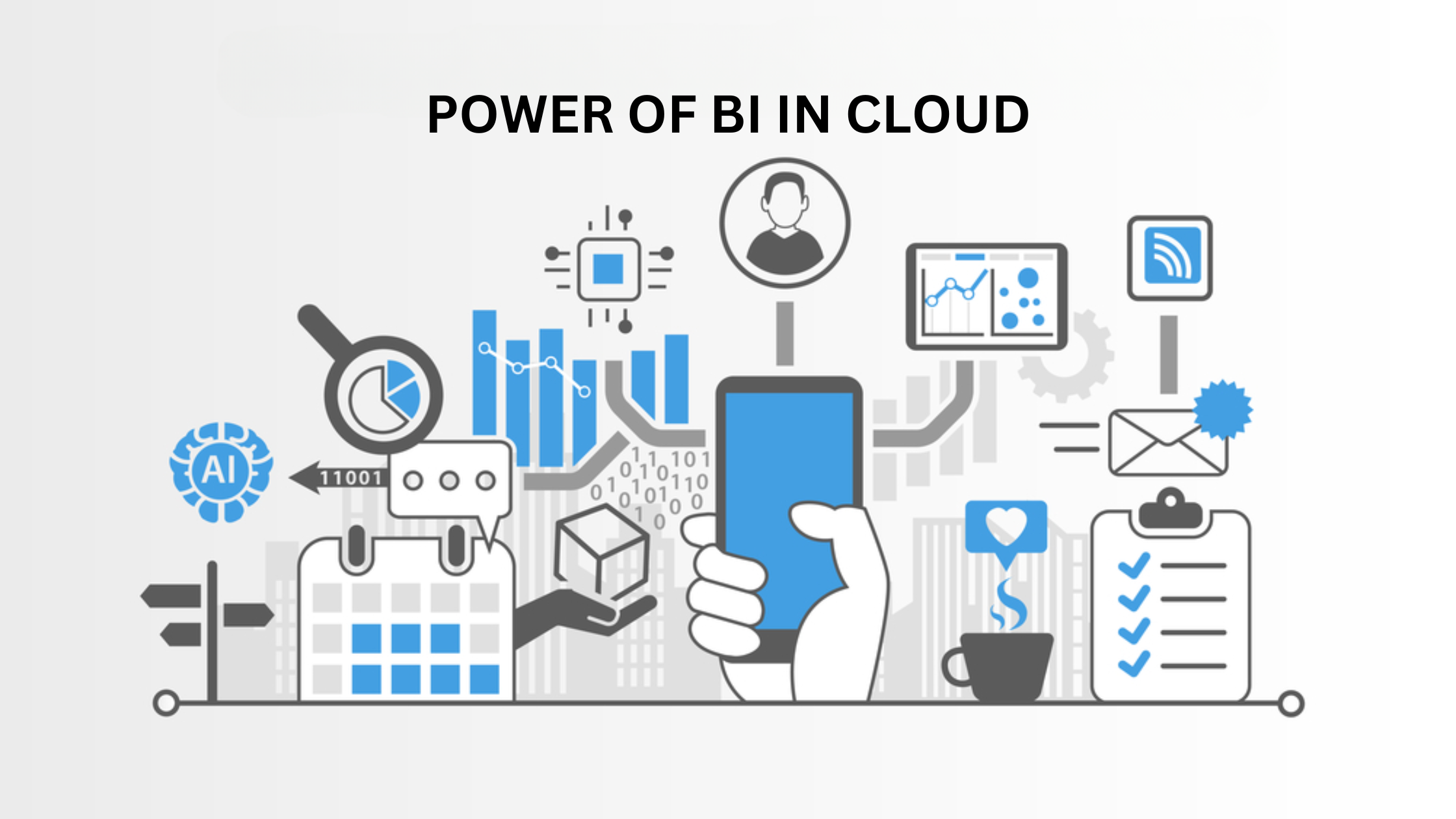
Introduction
Business Intelligence (BI) plays a crucial role. It helps examine through data, draw insights, and make smart decisions. However, as data becomes more extensive and intricate, the need for a scalable, flexible, and cost-effective BI solution grows. Enter cloud computing. Cloud-based BI comes with remarkable advantages like swift deployment, lower maintenance, enhanced performance, and easy accessibility.
But, like any solution, it brings challenges, including data security, integration issues, governance, and compliance concerns.
How can organizations navigate these hurdles and tap into the power of BI in the cloud?
This article dives into best practices, solid statistics, facts, and compelling case studies to illustrate the real impact of cloud-based BI.
Unveiling the Benefits: How BI in the Cloud Transforms Businesses

- Agility and Scalability
According to a survey by Gartner, by 2024, it is expected that 50% of new system deployments in the cloud will be based on a cohesive cloud data ecosystem rather than on manually integrated point solutions.
BI takes on a dynamic form in the cloud, offering unparalleled agility and scalability. Businesses can swiftly adapt to changing data demands and scale operations seamlessly, ensuring optimal performance.
- Cost-Efficiency Redefined
Cloud-based BI eliminates the need for hefty infrastructure investments. With a pay-as-you-go model, organizations can optimize costs, channel resources where needed and maximize return on investment. Organizations that move to cloud-based BI witness a substantial reduction in overall infrastructure costs.
This is because cloud-based BI solutions can eliminate capital expenses for infrastructure, including storage and servers, which present a significant investment for companies. This highlights the financial prowess of cloud solutions, aligning expenses with actual usage.
- Real-time Insights
Unlocking real-time insights becomes the new norm with BI in the cloud. Decision-makers can access up-to-the-minute data, enabling swift and informed decisions that propel the business forward. Here’s a case in point – a multinational retail giant implemented cloud-based BI, resulting in a 40% improvement in accessing real-time data. Making informed decisions on the spot enhances operational efficiency and customer satisfaction.
Navigating Challenges: Addressing the Complexities of BI in the Cloud
- Security Concerns
While the cloud offers immense advantages, security remains a paramount concern. Robust encryption, access controls, and continuous monitoring are imperative to safeguard sensitive business data. Facts underline the critical nature of security in cloud BI. According to a report by Rapid7, 68% of cloud-related breaches in 2021 were due to misconfigurations. Hence, implementing robust security measures is paramount to mitigate risks effectively.
- Integration Hurdles
According to a report by Gartner, the main barriers to cloud-based BI adoption are lack of trust in cloud providers (35%), integration complexity (30%), and data sovereignty and residency (28%). Integrating cloud-based BI with existing systems can be challenging and has various hurdles. However, meticulous strategy and robust middleware solutions are essential to ensure seamless integration and data flow. Adopt a phased approach to successfully navigate integration challenges and ensure a smooth transition, avoiding disruptions in day-to-day operations.
- Data Governance
Maintaining data integrity and compliance in the cloud is a multifaceted challenge. Implementing stringent data governance policies is crucial to uphold the sanctity of business data.
A recent survey emphasizes the importance of data governance in cloud BI. The IDC study said robust data management and governance are crucial factors for successfully integrating cloud-based BI. Businesses with comprehensive data governance policies experience increased data accuracy, mitigating the risk of regulatory non-compliance.
Best Practices: Charting a Course for Success in BI and the Cloud
- Strategic Planning

Initiate the journey into BI in the cloud with meticulous strategic planning. Clearly define objectives, assess data needs, and align BI initiatives with overarching business goals.
Take the example of Netflix, a pioneer in cloud technology, who attributes its success to meticulous strategic planning. By aligning BI initiatives with business goals, they increased customer satisfaction through personalized content recommendations.
Here’s how Netflix uses cloud technology and BI initiatives to achieve its business goals:
- Netflix uses AWS for nearly all its computing and storage needs, including databases, analytics, recommendation engines, video transcoding, and more—hundreds of functions that use more than 100,000 server instances on AWS.
- Netflix relies on AWS to help it innovate quickly and consistently deliver best-in-class entertainment. AWS provides Netflix with computing, storage, and infrastructure that allow the company to scale, operate securely, and meet capacity needs.
- Netflix also uses Amazon RDS and DynamoDB, which provide the structural organization that these are cloud services that help to build, develop and deploy custom machine learning models.
These facts suggest that Netflix is a pioneer in cloud technology and has a meticulous strategic planning process that aligns its BI initiatives with its business goals.
- Continuous Training and Upskilling
Invest in continuous training for your team. Equip them with the skills required to navigate the complexities of cloud-based BI, ensuring optimal utilization of available tools and features. Amazon’s cloud division, AWS, invests heavily in employee training. Their commitment to upskilling ensures that teams are well-versed in the latest BI tools, contributing to operational efficiency.
Here’s how AWS invests in employee training and how it affects operational efficiency, especially in navigating the complexities of cloud-based BI:
- AWS training programs aim to help employees develop skills in cloud computing, data centre operations, machine learning, and other advanced technologies.
- AWS provides a framework and best practices for achieving operational excellence in the cloud, which includes the ability to support the development and run workloads effectively, and gain insight into their operations.
This proves AWS invests heavily in employee training and has a strong focus on operational and performance efficiency in cloud-based BI.
- Regular Performance Audits
Conduct regular performance audits to identify bottlenecks and optimize BI processes. This proactive approach ensures that your cloud-based BI ecosystem operates at peak efficiency. Salesforce, a trailblazer in cloud CRM, conducts regular performance audits. This commitment to optimization reduced response time for customer queries, showcasing the impact of proactive performance management.
Leverage the Power of BI in the Cloud with Datacrew.ai
Datacrew.ai can help leverage the power of BI in the cloud by offering solutions that enable businesses to access, analyze, and visualize data from multiple sources in real-time. Datacrew.ai uses modern data stack technologies like Snowflake, BigQuery, Synapse, Redshift, etc., and tools like Tableau, PowerBI, Looker and Thoughtspot to build scalable, secure, and cost-effective data pipelines and dashboards.
We help businesses with digital transformation and change management by providing data-driven insights and recommendations to improve decision-making and performance.
We also offer end-to-end service across various areas of the data value chain, such as business intelligence, data engineering, artificial intelligence, data strategy, data management, data governance, and more!
If you are interested in learning more, book a free consultation today! Please email us at contactus@datacrew.ai or contact us here!